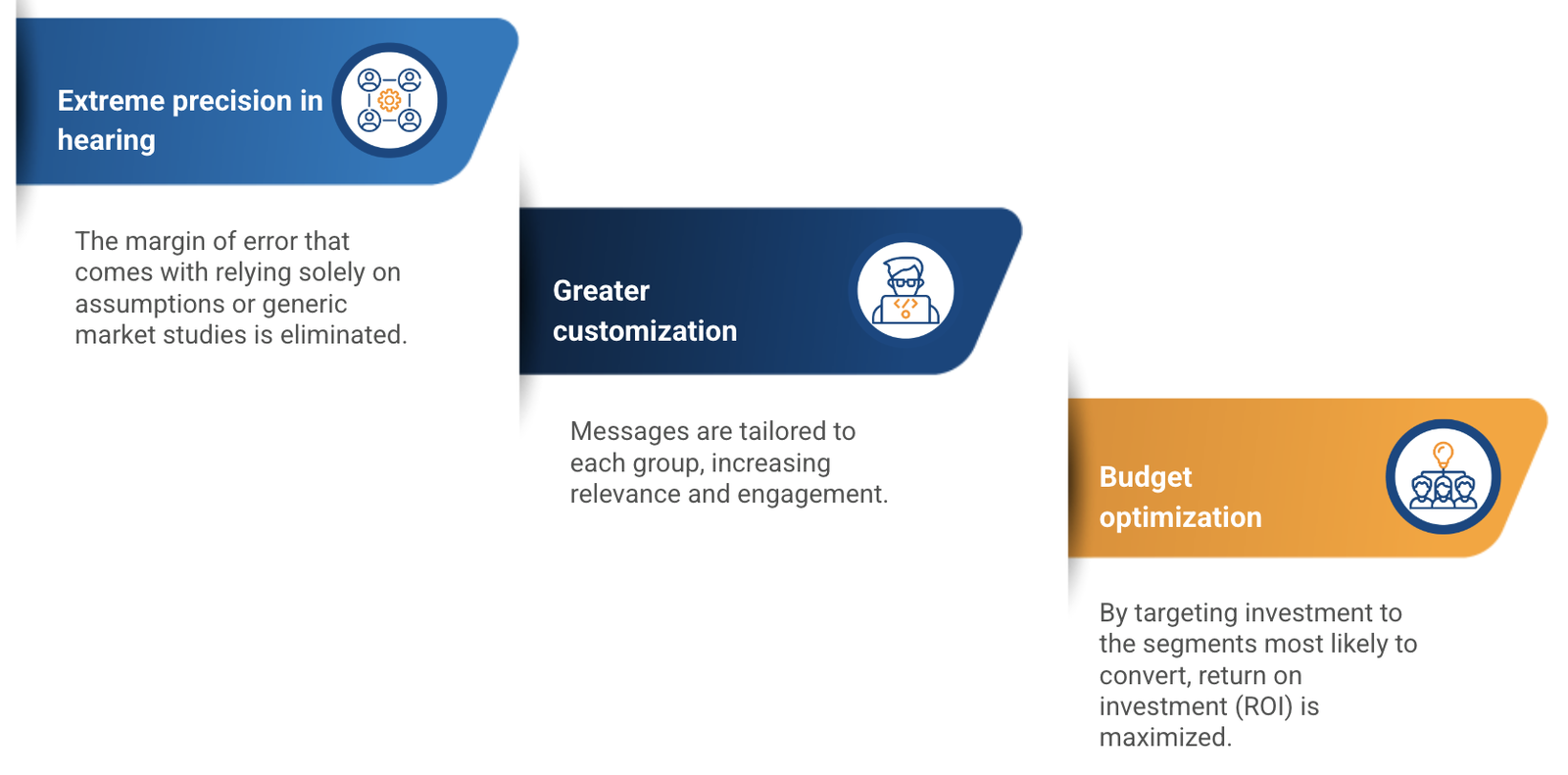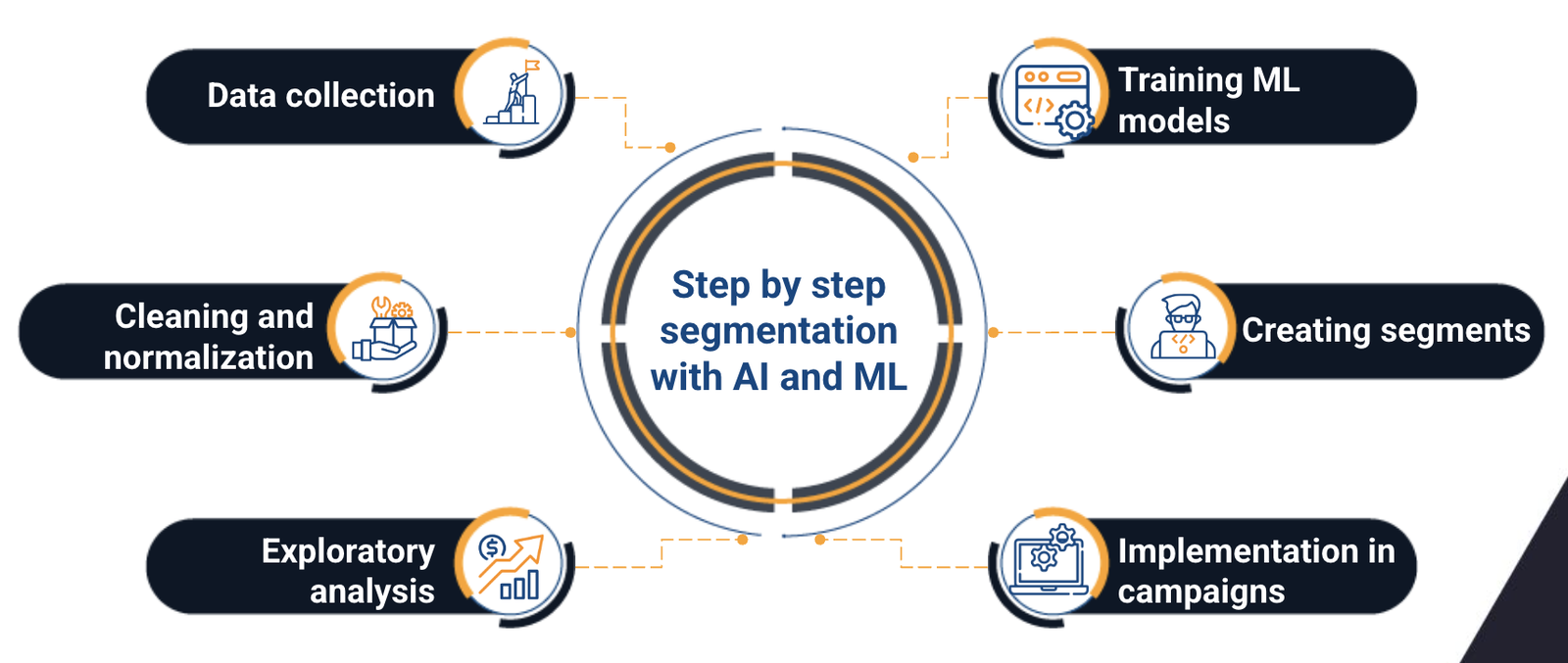
Why combining AI and ML in customer segmentation improves campaign performance
Table of contents
Quick Access

Imagine this situation: Your company launches a carefully designed marketing campaign. The creative team worked for weeks, the advertising investment was significant, and the message was compelling. However, when you review the results, the reach is high... but the conversions are minimal.
The problem isn't the product or the message, but that the campaign reached people who weren't ready—or interested—to buy. This is a common scenario that AI-powered customer segmentation can decisively resolve.

In a world where competition is intense and consumers expect personalized experiences, relying on basic criteria like age, location, or gender is no longer enough.
This is where the combination of Artificial Intelligence (AI) and Machine Learning (ML) revolutionizes the way companies understand and classify their customers, enabling the creation of more precise and profitable marketing strategies thanks to well-implemented AI customer segmentation.
What is AI customer segmentation?
AI customer segmentation is the process of dividing the customer base into specific groups using intelligent algorithms capable of analyzing massive amounts of data. Unlike traditional segmentation, which relies on limited parameters and manual analysis, AI analyzes multiple variables simultaneously:
- Purchase history.
- Social media behavior.
- Website interactions.
- Communication preferences.
- Consumption patterns and seasonality.
ML, as a branch of AI, allows the system to learn from each interaction and adjust segments in real time. Thus, customer segmentation with AI ceases to be static and becomes a dynamic and evolving process.
How AI and ML work together for better segmentation
Although AI and ML are often mentioned together, their role in AI-powered customer segmentation is complementary. AI provides the ability to process and correlate data from diverse sources, while ML detects patterns, predicts behaviors, and continuously improves segment accuracy.
Practical example: A retail company can use AI to collect transaction and social media data and apply ML to discover that a specific customer segment tends to shop more during the early hours of the day, prefers certain types of discounts, and responds better to messages sent via SMS than email.
This combination allows for the creation of hyper-personalized campaigns that increase the likelihood of conversion and reduce waste on audiences with no real interest, enabling AI-powered customer segmentation to translate into concrete results.
Direct benefits for campaign performance
For a company leader, tangible results are the most important thing. AI-powered customer segmentation offers key advantages:
- Extreme Audience Accuracy
The margin of error that comes with relying solely on assumptions or generic market research is eliminated. - Greater Personalization
Messages are tailored to each group, increasing relevance and engagement. - Budget Optimization
By targeting investment to the segments most likely to convert, you maximize return on investment (ROI). - Real-Time Measurement
AI not only segments but also measures the performance ofLive campaigns, allowing for immediate adjustments to optimize customer segmentation with AI at any time.

Use cases in key industries
AI-powered customer segmentation is applicable in almost any sector. Some examples:
Retail: Identify occasional buyers and convert them into repeat customers through personalized offers.
Financial Services: Differentiate risk profiles and offer products tailored to financial history and behavior.
Tourism: Detect travel trends and offer packages tailored to preferences and seasons.
Health: Personalize prevention campaigns or medical service promotions based on demographic groups and habits.
Technology and SaaS: Create plans or features tailored to different usage levels and customer needs.
The step-by-step process of segmentation with AI and ML
A successful customer segmentation project with AI typically follows these steps:
- Data collection: Integrate information from multiple channels (CRM, social media, e-commerce, customer service, etc.).
- Cleaning and normalization: Ensure data is accurate and in a usable format.
- Exploratory analysis: Detect initial patterns and relationships between variables.
- ML model training: Apply algorithms such as clustering, predictive models, or behavioral analysis.
- Segment creation: Group customers according to criteria derived from the analysis.
- Campaign implementation: Adapt messages, channels, and offers to each segment.
- Monitoring and continuous improvement: ML adjusts and refines segments with each new piece of data so that AI-powered customer segmentation remains effective.

Challenges and considerations for business leaders
Although the benefits are clear, it is important for a leader to consider certain aspects before implementing customer segmentation with AI:
- Data Quality: Without accurate and complete data, even the best algorithm can fail.
- Legal Compliance: Comply with privacy regulations such as GDPR or CCPA.
- Investment in Talent and Technology: Have data specialists or trusted providers.
- Cultural Shift: The company must adopt a mindset focused on data-driven decisions.
Impact on ROI and customer relationships
When a company combines AI and ML for segmentation, it not only improves campaign performance but also builds stronger relationships with its customers. Each interaction is perceived as more relevant, increasing satisfaction, loyalty, and, in the long run, customer lifetime value (CLV).
Recent studies show that companies that apply AI-powered customer segmentation can increase their ROI on digital campaigns by up to 30% and reduce unnecessary spending on unprofitable audiences by 20%.
Conclusion
In a market saturated with advertising messages, the key is no longer shouting louder, but speaking directly to the right people. The combination of AI and ML in AI-powered customer segmentation enables business leaders to transform data into precise, optimized actions.Maximize every dollar invested and connect more effectively with your audience.
It's not just about technology, but about strategic vision: understanding that in the age of mass customization, knowing your customer on an individual level is the best way to win their attention... and their loyalty. Let's work together!
We recommend you this video
Related blogs

IT Outsourcing in Chicago vs IT Outsourcing in New York: Which is better?

How software outsourcing can reduce costs by up to 50%

IT outsourcing for data analytics and ML
